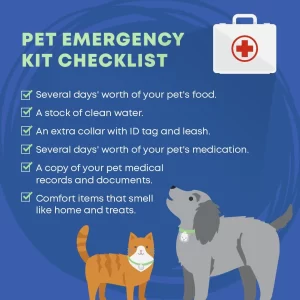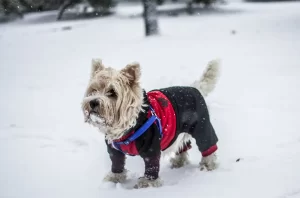How to Protect Your Pet When Disaster Strikes

By Uchenna C. Okeke
Natural disasters like floods, winter storms, hurricanes and tropical storms can be overwhelming. Our companion animals depend entirely on us for protection in times of crisis so we must be prepared to handle the situation before, during and after it occurs. Different disasters pose unique risks, so knowing how to protect your pet in each situation is important. Let’s explore the steps you can take to keep your pet safe.
BEFORE
Know Where to Go Before You Have to Leave
It’s important to have an evacuation plan that includes your pet. Research nearby pet-friendly shelters, hotels, or safe places ahead of time, as not all shelters accept animals. Keep a list of veterinary clinics, animal shelters, or friends who can help if needed. Advance planning helps you act quickly and avoid last-minute stress.
Pack a Pet Emergency Kit
Just as you prepare an emergency kit for yourself, it’s vital to have one for your pet. Your pet’s kit should include:

Ensure Proper Identification
Disasters can separate pets from their owners, making identification vital. Ensure your dog wears a secure collar with an updated ID tag. All pets should be microchipped with your current contact details as this greatly increases the chances of being reunited if you become separated.
DURING
Evacuate Safely
Disaster conditions can worsen quickly, so keep your pet in a secure carrier or on a leash at all times to prevent them from running away in fear. If evacuating by car, ensure they are safely restrained to prevent panic-driven escape attempts.
Keep Your Pet Calm in the Chaos
Pets pick up on human emotions, so staying as calm as possible will help reassure them. If you’re sheltering in place, keep your pet in a safe, enclosed area away from windows, loud noises, and dangerous objects. Provide comfort with familiar items, speak soothingly and avoid sudden movements to help ease their anxiety.

AFTER
After the disaster, your pet may still face health risks like injuries, dehydration, or emotional distress.
Check for injuries
Inspect your pet for cuts, burns, or breathing difficulties. Seek veterinary care if needed.
Provide a stable routine
Keeping their food, sleeping, and play schedules consistent helps them feel secure.
Watch for behavioral changes
Some pets may become anxious or fearful after a traumatic event. Be patient. Pets, like humans, need time to heal after trauma.
Protecting Pets in Specific Situations
Floods
If you live in a flood-prone area, plan evacuation routes in advance. During a flood, keep pets indoors in an elevated, safe space. If evacuating, use a secure carrier or leash and move to higher ground. After the flood, check for mold, toxic chemicals, and sharp debris that could harm your pet.
Winter Storms
Winter storms bring cold, snow, and ice that can harm pets. Keep them indoors in a warm, dry area. If they go outside, limit their time in the cold, wipe their paws, and use a coat or booties if needed. Stock up on food, water, and supplies in case of power outages, and be ready to evacuate if needed. For more information, read 12 Cold Weather Safety Tips.

Hurricanes/Tropical Storms
Strong winds and flying debris pose serious risks. Keep your pet in a secure room, away from windows and unstable furniture. If evacuating, transport them in a sturdy carrier or on a leash. After the storm, inspect the area for hazards before allowing them outside.
Conclusion
Natural disasters can be traumatic for pets as they are for humans. Unlike us, pets don’t understand what’s happening—they simply sense the fear, chaos, and sudden changes. In those critical moments, every second counts and with the right preparation, you can protect yourself and loved ones, including your pet. Always remember that when disaster comes, being ready can make all the difference.
